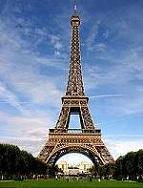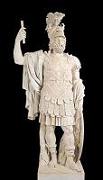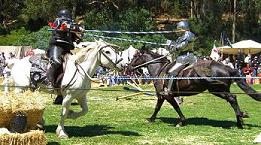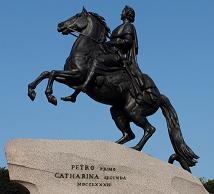|
|
|
|
|
|
|
 |
 |
 |
|
THE
SECOND SMALLEST CONTINENT IN THE WORLD EUROPE
contains wealthy and extremely diverse community of cultures. In most
peoples’ minds, it is probably not a continent particularly associated with
indigenous martial arts. However, Europe has a long and fascinating martial
arts history. As power-bases among civilizations came and went—often as a
result of violent conflict and large-scale warfare—martial arts developed as
a response to the environment in which warriors found themselves. |
|
THE TERM
"MARTIAL ART" comes from Latin—it
means “the arts of Mars,” after the Roman god of war—and was coined to
celebrate the martial prowess Roman gladiators displayed during their bloody
and brutal battles in the arena. And although most popular Western
indigenous martial-art forms have gone on to become sports—such as fencing
and many forms of boxing they really only represent the tip of the iceberg.
The European tradition of martial arts is actually as rich and engaging as
that found in Asia, and many European art forms offer their practitioners
enhanced self-development capabilities. |
 |
|
A founding father
The best-known European martial art is Pankration, an unarmed combat
technique. A combination of Greek boxing, wrestling, and grappling, it
focused on the use of knees, elbows, kicks, punches, and chopping movements,
alongside joint-locks and choke-holds. It was a brutal, competitive sport
and, although eye-gouging and biting were forbidden, pretty much anything
else was acceptable. The goal of the game was to force an opponent to submit
and, in many ways, this 2,000-year-old art bears a striking resemblance to
the modern mixed martial arts and ultimate fighting championship movements
prevalent in martial arts today. |
|
Pankration was so effective that the young
Alexander the Great, on his
conquest to dominate the world, trained his troops rigorously in pankration
for close-quarter, hand-to-hand battle with the enemy, along with the use of
the spear, the shield, and the sword. His conquest of Asia would certainly
have led to a cross-fertilization of fighting techniques between the Greek
warriors and the indigenous civilizations with whom they came into contact. |
 |
|
Martial arts were also popular in ancient Rome, not only as a
gladiatorial sport but also among civilians of many different social
classes, who would engage in knife-fighting for self-defense. Highly
codified fighting systems evolved as a result of this fashion and, as the
Roman Empire went into decline, other indigenous martial arts started to
prosper: records of Germanic and Celtic warrior practices, for example, show
detailed training methods and a complex repertoire of movements, in
addition to alternative philosophical beliefs. |
 |
Moving with
the times
The knights of the Middle Ages were the romanticized ideal and embodiment
of martial arts and chivalry. They developed a staggering array of weapons
for combat, training, and sport, such as those used in
Jousting.
Technological advances and improved metal-forging techniques during this
period saw drastic improvements in armor, some of which was so well crafted
that the United States’ space agency, NASA, still studies medieval
plate-armor design when it develops new spacesuits today. |
|
Martial
arts and religion
Christian monks have a close
connection with European martial-art traditions, much as Buddhist or Daoist
monks influenced Asian martial arts. In the 13th century, Germanic monks
were well known for practicing martial arts as a sport, a pastime, as a
means of improving their fitness, and so that they could defend both their
churches and their religious beliefs. Some Western monks were so proficient
in unarmed wrestling matches that even knights were often unwilling to
challenge them through fear of losing face. If challenged by monks, many
knights would only engage them in weapons fighting, as traditionally a
knight’s sword skills were second to none.
Literary
resources
Many quality publications,
dating back centuries, can be found describing the techniques, philosophy,
and tactics of ancient European martial arts. Fabian von Auerswald produced
a fascinating illustrated manual in the 1500s, which describes, in good
detail, joint-locking techniques, throwing methods, and pin holds, alongside
ground grappling and other wrestling tactics.
One of the most famous
literary sources, the Collecteanea, first published in 1509 by master
of arms Pietro Monte, is a body of literature on weapons, mounted fighting,
and wrestling. The work outlines the importance of physical fitness in
relation to being an effective warrior. The book also describes fighting
tactics and the underlying philosophy of exploiting vulnerable areas and
openings in the opponent’s guard and attack—similar to the philosophies
found in Asian martial arts.
An illustrated guide written
by Johann Georg Paschen in 1659, Vollstandiges Ring-Buch, describes
martial-art techniques such as parrying, boxinglike punches, arm locks, and
finger jabs, along with submission holds, chokes, and techniques for
countering and disarming assailants with edged weapons.
|
Eastern
European Martial Arts
Russia has also had a long
history of martial-arts practice, both in unarmed wrestling and in
weapons-based arts. Some of these arts were so effective that, when Peter
the Great assumed power in 1682, one of his first acts of office was to ban
stick fighting among the peasants. Banning the practice of martial arts has
been a common occurrence throughout the history of many of the world’s
cultures and was used as a tactic to thwart any possibility of warrior clans
challenging the government or power-base in authority at the time. |
 |
|
Change of
direction
The biggest change to the face
of European martial arts, however, came during the late 1600s with the
advent of firearms. This naturally led to a decline in the practice of
unarmed martial arts and those employing edged weapons. This technological
advancement quickly swept the world and led to an unprecedented
transmutation of combat arts. As a result, the emphasis of martial arts
shifted more toward self-defense and self-development, as opposed to the
previous, more brutal emphasis on battlefield killing.
|
|
|
|
|













